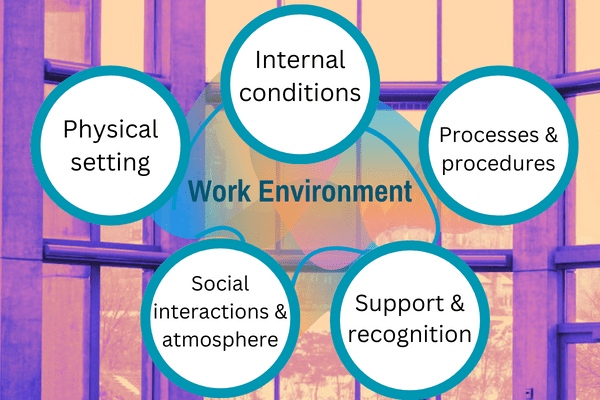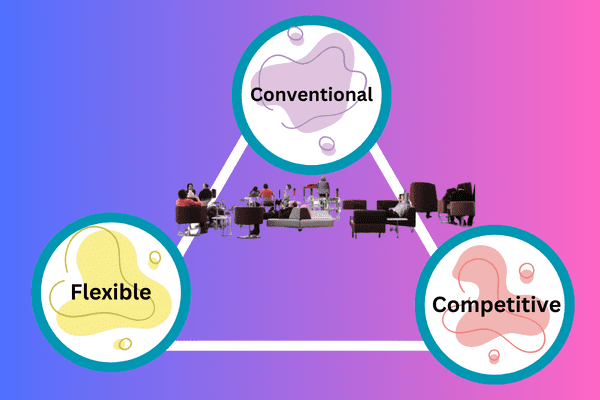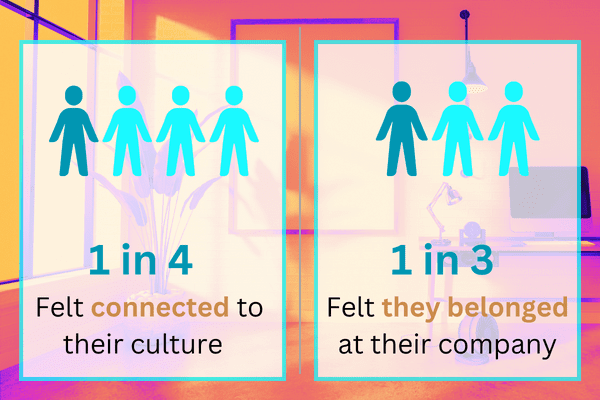Is Your Work Environment Affecting Your Bottom Line?
The work environment is, in one respect, the place where people do their work. But the reality is, it’s far more than just the building where the magic happens – if you’re lucky.
As a matter of fact, it’s about the company’s processes and procedures, how the people get on, and how they’re supported. In other words, it’s the work culture as well.
Why Are Positive Work Environments So Important?
Positive work environments make people happier and more comfortable while they work. Moreover, when your employees are happier, they are:
- Efficient
- Creative
- Content
- Productive
A positive work environment makes all the difference in the world in whether people decide to take a job, and how long they stay. Overall, the work environment has a major impact on people’s well-being and performance, and hence the business’s bottom line. Whatever kind of boss you are, that’s why this stuff matters.
What Do We Mean by ‘Work Environment’?

A work environment encompasses the physical setting, the workplace set-up and the physical conditions in which people perform their jobs. So, an office will have workstations, IT equipment and printing facilities. And the furnishings will also impact the work environment.
On top of that, there’s the leadership and management team’s working styles and the impact they have on the team, how people get on with each other and work together, and whether there are set hours, or it’s flexible.
All these factors have the potential to significantly impact employees’ morale, workplace relationships, performance, job satisfaction, and even their health. Further down, we’ll look at these in more detail.


>> Mental health coaching cards <<
Let’s Get to the Heart of This. What Are Some Synonyms of Work Environment?
As well as the physical, social, and cultural surroundings in which an individual does their job, the work environment includes factors such as the organisational culture, team dynamics, management practices and, of course, the demands of the job.
So, What is a “Good” Work Environment?
Michigan State University say “positive” work environments can be defined as those workplaces where there is trust, cooperation, safety, risk-taking support, accountability, and equity.
These are abstract concepts, for sure, and in today’s economic climate, many hard-pressed bosses will likely be more concerned about what’s happening with their KPIs and other “tangible” results. Understandably, this is fair enough.
Meanwhile, the experts break “the work environment” into these components:
The 5 Components of the Work Environment

- Physical setting
- Internal conditions
- Processes and procedures
- Social interactions and atmosphere
- Support and recognition
Let’s look at what each of these comprises:
Component #1 – The Physical Setting:
We all want to work in a place that we like. So, the physical setting means:
- The building where you work.
- How well-maintained it is.
- Its location, including parking and public transport connections.
- Access to shops and food outlets, and other amenities.
- How safe and pleasant the neighbourhood is.
Component #2 – The Internal Conditions:
No one will do their best work if they aren’t physically comfortable and at ease in their surroundings. The internal conditions we’re talking about here include:
- The design and décor: How do they enhance our performance?
- Lighting and temperature, and their sufficiency for the work: Are you sitting, or standing, comfortably?
- Safety and minimisation of hazards: Do people feel physically safe working there? Is there disabled access?
- The maintenance of the building interior and furniture: You’ve got to be here, Sure. But is this somewhere you really want to be?
- The state of the toilets, kitchens, and break areas: Are they in good upkeep? Are they sufficient for the number of staff working there?
- The suitability of the equipment that people use in their work: Is it fit for their needs?
The processes and procedures people follow in a workplace are also part of the work environment. This brings us to:
Component #3 – Processes and Procedures
To ensure this important part of your business contributes to a positive work environment and doesn’t make things worse, you need to ask:
- Are our processes and procedures effective, supportive, and appropriate for the work our people do, or do they lead to increased bureaucracy, wasted time, inefficiency, and resentment? How do they tie in with the culture we want to foster?
- Do our people feel the processes they have to follow are the right ones, and have they been consulted?
- Would they feel welcome to suggest improvements?
The Human Factor in The Work Environment
Leaders and managers can greatly motivate their people by ensuring they understand and appreciate why things are done in a particular way. Note that this is an important element of people-oriented leadership and participative management. As we said, the “work environment” also takes in what it’s like to work there, and whether people are happy. This brings us to:
Component #4 – Working Culture and Social Interaction
You can’t afford to overlook the working culture and the interactions that take place. We come to work as much to feel fulfilment in our jobs, be with people we get on with and have a good time, as we do to get paid. So, leaders and managers need to think about:
- The business culture and whether it’s formal, flexible, or competitive – or something else again.
- The leaders and managers’ leadership and management styles, and the effect they have on their people.
- The social environment, including how the leaders, managers, and team members interact.
- The general atmosphere between leaders, managers, and colleagues: Team spirit, collaboration, friendliness, and inclusion.
Of course, we can’t forget the contribution of social activities, either during or outside working hours, such as events, outings, seasonal celebrations, and team-building exercises.
Lastly, the fifth component follows from the working atmosphere and social interactions.
Component #5 – Support and Recognition
Support and recognition are particularly important in making the work environment a place where people feel welcome and motivated. Additionally, it’s essential for leaders and managers to have a feel for what is happening with this aspect of their business. For starters, you can measure the level of support your employees feel they are getting, by asking these questions:
- Is there appropriate training and development to enable them to do their job to the required standard? Do they feel encouraged and fulfilled?
- If they have concerns, can they raise them, so they’re heard and addressed, and is their contribution recognised?
- Do colleagues work well as a team, and support each other in their roles? Do they feel part of a wider team effort and understand how their role fits within the company?
And Let’s Not Forget – Equity, Diversity and Inclusivity
Equity, Diversity and Inclusivity contribute to a richer, more sympathetic work environment. Ideally, when you’re hiring people, you should welcome candidates from a diverse range of backgrounds and experiences, including:
- Age
- Cultural background
- Educational background
- Gender
- Gender identity
- Neurodiversity
- Physical ability
- Race
- Religion
- Sexual orientation
Leading on from this, Human Resources, or HR, means more than finding people to fill jobs. Actually, it’s about treating them as valued assets and developing them. And that means, creating an environment where they feel happy, and motivated to do their best.
Progressive companies realise how important this is. Hence, many businesses see the work environment as a central part of the Employee Value Proposition.
3 Types of Environments for Working

We mentioned the business culture and whether it’s formal, flexible, competitive – or something else altogether. Let’s look at these three types of work environments:
#1 – Conventional:
This is formal, conservative, and relatively inflexible. People work traditional business hours, typically 9 to 5, from Monday to Friday. And there are dress codes.
Things are getting less rigid regarding how we “present” now. But even so, conventional businesses often have guidelines on what’s deemed appropriate, which can be challenging for some people.
There’s a mindset thing, too. Organised people who like working toward specific objectives tend to like this environment. It’s especially suited to administrative and financial roles. In such businesses, there’s also likely to be a hierarchy, with clear levels of seniority, where people respect the position, rather than the person.
Outside office-based work, ‘conventional’ also applies to task-based work, like manufacturing, retail and distribution and so on. Here again, there are clear roles, rules and expectations about how things are done.
#2 – Flexible:
This environment lets people adapt their hours, work schedules or workspace as they prefer. In return, they agree to work to a high standard and defined timescales.
Companies who adopt this approach might feel they’re taking a leap of faith, but generally, they get more out of their people by letting them work in ways that suit them.
Specifically, flexible environments tend to have relaxed hierarchies and work schedules, which benefit both the company and the people. Self-motivated, driven individuals do well in this setting, but people who lack self-discipline may not.
#3- Competitive:
Environments like this are especially popular with sales teams. They are driven by competition, with people working towards targets. There are often financial rewards or benefits for teams and individuals who meet their goals.
All in all, to do well, people must be assertive and driven to succeed. It sounds tough, but the output is high because the people are happy in their work and know how to maintain a healthy work-life balance. As a result, this helps the company attract and keep good people.
Take 2 – What is a Good Working Environment?

Previously we quoted Michigan State University saying this involved trust, cooperation, safety, risk-taking support, accountability, and equity. These qualities are implicit in the next list of what these three environments ideally have in common when it comes to positive workplace culture:
- Open and clear communication
- Ample growth opportunities
- Emphasis on creativity
- Healthy work relationships
- Well-defined purposes
- Enticing reward systems
- A strong code of ethics
How Important is All This to Employees?
As we said at the top of this article, the work environment is about more than just the building you’re In. In fact, it’s the work culture too. Above all, a positive work environment is crucial for keeping good people.
To prove it, here are some stats from the human capital software company Workhuman. They teamed up with the research company Gallup to study employees across the US, the UK, and Ireland. The results are chilling.
Just 1 in 4 strongly agreed they felt connected to their culture. Worse, only 1 in 3 strongly agreed that they felt they belonged at their company.

If people don’t feel they belong, they’re unlikely to want to stay. And we all know that if you find good people, you want to keep them.
How Does It Affect Us Psychologically?
Employers need to think about how the work environment affects people psychologically. In his 1959 book ‘The Motivation to Work,’ American psychologist Frederick Hertzberg proposed that we have two sets of needs.
The first set has become known as Hertzberg’s Motivators. Basically, they concern our higher human nature and our drive to grow psychologically.
The other, the Hygiene Factors, affect the evolved mammal part of our nature, which seeks to avoid discomfort. The two interact powerfully in our response to the work environment. And a bad response can affect our mental health.
Hertzberg’s hygiene factors are:
- Company Policies
- Supervision
- Work relationships
- Remuneration
- Salary
- Security
- Work conditions
Things have clearly moved on since Hertzberg published his theories in 1948. But they still offer today’s leaders and managers valuable insights to go by.
Finally: How Can You Make Your Environment Better?
Actually, if you’re a leader or manager, there’s a lot you can do to improve things. Start by asking yourself, how would you personally describe your current work environment? Be honest, specific, and objective. Avoid exaggerating the positives or sugarcoating the negatives.
Next, ask your team. Carrying out a poll on how they see their work environment offers companies a good way to find out what motivates employees. Also, checking in regularly with your team will highlight areas for improvement and show which ones they see as more important. But that doesn’t mean you should neglect the other areas they don’t mention!
Take a 360-degree View of the Work Environment and Employee Welfare
Going back to Hertzberg, his two-factor theory maintains that employers shouldn’t choose to focus on either motivation (good) or hygiene (bad). Instead, they should work to deliver on both and shape company policy to improve employee welfare. All in all, employee satisfaction means paying attention to a range of needs in both areas.
If you want to ‘walk the talk‘ in your business, here are some suggested ways to achieve a better work environment from OC Tanner, the US employee recognition solutions provider:
10 Top Tips to Improve Your Work Environment:

1. Lead more effectively:
Micromanaging, at one extreme, and being overly hands-off, at the other, can both be just as damaging.
2. Provide comfortable workspaces:
From ergonomics and lighting to noise and even adequate space, there are many little things that can make a difference.
3. Offer good break facilities:
This third point is not just about the food. Also think about the furnishing and seating, outdoor spaces, privacy options and the like.
4. Critique the layout:
Optimise the workspace layout to make it easier for people to do their work.
5. Better work-life balance:
Detox your team by encouraging a better work-life balance. One way to do this is to find out who’s working long hours.
6. Remember the work hours:
Don’t make people feel guilty for not answering emails at weekends or in the evenings.
7. Clamp down on gossip and exclusionary behaviour:
People can be cruel to anyone who’s a bit different. Make your business a safe place for people to be themselves.
8. Deliver on the Equity part of ED&I:
Offer everyone a chance to progress in their roles and get the training they need.
9. Listen out for a lack of enthusiasm:
If people seem to be only doing their jobs so they get paid, you’ve probably got a motivation problem. Find out what’s going on.
10. Keep people in the loop:
Lastly, good communication from leaders and managers, with clear feedback and stated expectations, will make things better. And keep the conversation going!




